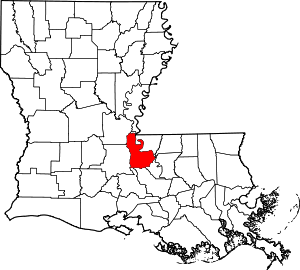On June 25, 1791, a group of enslaved Mina gathered on the estate of the widow Robillard in New Roads, Pointe Coupée Parish. Jean-Louis, who was enslaved there, organized regular balls for Mina men.
| Part of a series on |
| North American slave revolts |
|---|
 |
On June 25, 1791, a group of enslaved Mina gathered on the estate of the widow Robillard in New Roads, Pointe Coupée Parish. Jean-Louis, who was enslaved there, organized regular balls for Mina men. During the gathering, a plan was made for the Mina to rise up and free themselves,[1] gathering pickaxes, knives, and other weapons to mount an attack on a storekeeper who could be raided for guns, gunpowder, shot, and other weapons.[2] The only two non-Mina people involved were Cæsar, from Jamaica (ethnically an Ashanti), and Pedro Chamba, who was ethnically Chamba but had been raised by the Mina.
Conspiracy
The conspirators planned to launch the attack on the night of July 7, 1791, but poor weather and the need to gather Mina from other plantations in Pointe Coupée delayed the uprising until July 9. With the delay, Jacó attempted to enlist additional supporters, including an enslaved man named Dique. Dique was hesitant to join the conspiracy and confided in Venus, who like him was Ado, not Mina. Venus did not trust the Mina and reported the plans to her slave holder, Georges Oliveau, who in turn passed word to an officer of the local militia.[2]
The militia posted guards on roads throughout the area and dispatched troops to capture the conspirators. In total, 17 enslaved men, including Jacó, were arrested and sent to New Orleans for trial. Their trial began in March 1792, but the Spanish colonial officials lacked interpreters necessary for the witnesses and defendants who spoke only French or Creole. By June 1794, 16 of the conspirators (one had drowned himself before reaching New Orleans), were returned to the plantations where they were enslaved.[2]
In reaction to the attempted revolt, Governor Carondelet ordered slave holders to control people in bondage in a more "humane" manner, as well as to provide better food and clothing. However, these efforts were not enough to avoid the Pointe Coupée Slave Conspiracy of 1795.[2][3]
See also
References
- ^ "Pointe Coupée, Louisiana 1791". Louisiana Slave Conspiracies. Retrieved September 10, 2021.
- ^ a b c d Richard Jr., Ulysses S. (1992). "The Pointe Coupée Slave Conspiracy of 1791". Proceedings of the Meeting of the French Colonial Historical Society. 15: 116–129. JSTOR 42952223.
- ^ Ricard, Ulysses S. “The Pointe Coupée Slave Conspiracy of 1791.” Proceedings of the Meeting of the French Colonial Historical Society, vol. 15, Michigan State University Press, 1992, pp. 116–29, http://www.jstor.org/stable/42952223.
| Part of a series on |
| North American slave revolts |
|---|
 |
The Pointe Coupée Slave Conspiracy of 1795 was an attempted slave rebellion which took place in Spanish Louisiana in 1795. It has attracted a lot of attention and been the subject of much historical research.[1] It was preceded by the Pointe Coupée Slave Conspiracy of 1791.
Trial
On May 4, 1795, 57 enslaved people and three local white men were put on trial in modern day Pointe Coupée Parish after an attempted slave conspiracy in the vicinity of the Pointe Coupee military post. Planters found a copy of Victor de Mirabeau (Mirabeau the Elder)'s Théorie de l'Impôt, which included the Declaration of the Rights of Man and of the Citizen of 1789, in one cabin.[2] The trial ended with 23 of the enslaved people being hanged, their corpses decapitated, and their heads posted along the road. 31 more were sentenced to flogging and hard labor. All three white men were deported with two sentenced to six years forced labor in Havana.[3]
See also
References
- ^ Hall, Gwendolyn Midlo (1992). "The 1795 Slave Conspiracy in Pointe Coupée: Impact of the French Revolution". Proceedings of the Meeting of the French Colonial Historical Society. 15. Michigan State University Press: 130–141. JSTOR 42952224.
- ^ Rasmussen, Daniel (2011). American Uprising: The Untold Story of America's Largest Slave Revolt. Harper Collins. p. 89.
- ^ Hall, Gwendolyn Midlo (1992). Africans in Colonial Louisiana. Louisiana State University Press. p. 344. ISBN 9780807116869.

